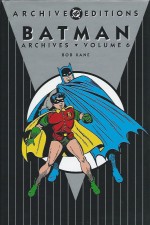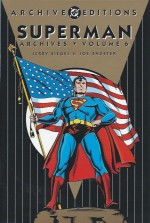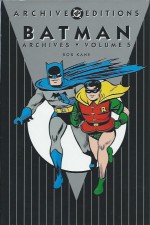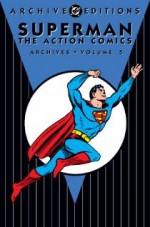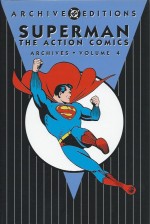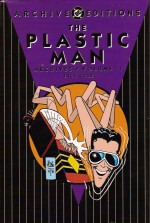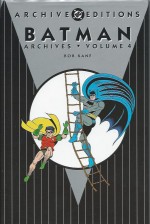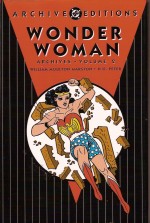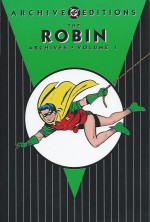
By Bob Kane, Bill Finger, Win Mortimer, Jim Mooney & various (DC Comics)
ISBN: 978-1-4012-0415-0
Robin the Boy Wonder debuted in Detective Comics #38 (April 1940), created by Bob Kane, Bill Finger & Jerry Robinson and introduced a juvenile circus acrobat whose parents were murdered by a mob boss. The story of how Batman took the orphaned Dick Grayson under his scalloped wing and trained him to fight crime has been told, retold and revised many times over the decades and still regularly undergoes tweaking to this day.
In the comics continuity Grayson fought beside Batman until 1970 when, as an indicator of those turbulent times, he flew the nest, becoming a Teen Wonder college student and eventually leader of a team of fellow sidekicks and young justice seeker – the Teen Titans.
He graduated to his own featured solo spot in the back of Detective Comics from the end of the 1960s, which he alternated and shared with Batgirl, and held a similar spot throughout the 1970s in Batman and won a starring feature in the anthology comic Batman Family and the run of Giant Detective Comics Dollar Comics. During the 1980s he led the New Teen Titans, first in his original costumed identity but eventually in the reinvented guise of Nightwing, re-establishing a turbulent working relationship with his mentor Batman.
His creation as a junior hero for younger readers to identify with has inspired an incomprehensible number of costumed kid crusaders, and Grayson continues in similar innovative vein for the older, more worldly-wise readership ofAmerica’s increasingly rebellious contemporary youth culture… but his star potential was first realised much earlier in his halcyon career…
From 1947 to 1952, (issues #65-130) Robin the Boy Wonder had his own solo series and regular cover spot in Star Spangled Comics at a time when the first superhero boom was fading to be replaced by more traditional genres such as crime, westerns and boys’ adventure stories. The stories blended in-continuity action capers with more youth-oriented fare with adults Batman and Alfred reduced to minor roles or entirely absent, allowing the kid crusader to display not just his physical skills but also his brains, ingenuity and guts.
This stellar deluxe hardback Archive compilation gathers together the first 21 tales from Star Spangled #65-85 covering February 1947 to October 1948, recapturing the bold, verve and universal appeal of one of fantasy literature’s greatest youth icons, opening with a fascinating Foreword by Roy Thomas, who discusses the origins and merits of boy heroes and the history of the venerable anthology title before offering some insightful guesses as to the identity of the generally un-named writers of the Robin strip.
Although almost universally unrecorded, most historians consider Batman co-creator Bill Finger to be the author of most if not all of the stories in this volume and I’m going to happily concur here with that assessment until informed otherwise…
Star Spangled Comics #65 started the ball rolling with ‘The Teen-Age Terrors’ illustrated by regular artist Win Mortimer (with the inking misattributed to Charles Paris) in which the Caped Crusaders’ faithful butler happens across an unknown trophy and is regaled with Dick’s tale of the time he infiltrated a Reform School to discover who inside was releasing the incarcerated kids to commit crimes on the outside…
That tale segues seamlessly into ‘The No-Face Crimes’ wherein the Boy Wonder acted as stand-in to a timid young movie star targeted by a ruthless killer, whilst #67 revealed ‘The Case of the Boy Wonders’ which saw our hero as part of a trio of boy geniuses kidnapped for the craziest of reasons…
An outrageously flamboyant killing in #68 resulted in the pre-teen titan shipping out on a schooner as a cabin and spending ‘Four Days Before the Mast’ to catch the murderer, after which modern terror took hold when Robin was the only one capable of tracking down ‘The Stolen Atom Bomb’ in a bombastically explosive contemporary spy thriller.
Star Spangled Comics #70 introduced an arch-villain all his own as ‘Clocks of Doom’ saw the debut of an anonymous criminal time-and-motion expert forced into the limelight once his face was caught on film. The Clock‘s desperate attempts to sabotage the movie Robin was consulting on inevitably led to hard time in this delightful romp (this one might possibly be scripted by Don Cameron)…
Chronal explorer Professor Carter Nichols succumbed to persistent pressure and sent Dick Grayson back to the dawn of history in #71’s ‘Perils of the Stone Age’ – a deliciously anachronistic cavemen and dinosaurs epic which saw Robin kick-start freedom and democracy, after which the Boy Wonder crashed the Batplane on a desert island and encountered a boatload of escaped Nazi submariners in ‘Robin Crusoe’ in a full-on thriller illustrated by Curt Swan & John Fischetti.
In #73 the so-very tractable Professor Nichols dispatched Dick to revolutionary France where Robin battled Count Cagliostro, ‘The Black Magician’, in a stirring saga drawn by Jack Burnley & Jim Mooney, after which the Timepiece Terror busted out of jail determined to have his revenge in ‘The Clock Strikes’, illustrated in full by Mooney who would soon become the series’ sole artist.
However Bob Kane & Charles Paris stepped in for the tense courtroom drama in #75 as ‘Dick Grayson for the Defense’ found the millionaire’s ward fighting for the rights of a schoolboy unjustly accused of theft, after which cunning career criminal The Fence came a cropper when he tried to steal 25 free bikes given as prizes to Gotham’s city’s best students in ‘A Bicycle Built for Loot’ (Finger & Mooney).
Prodigy and richest kid on Earth, Bert Beem was sheer hell to buy gifts for, but since the lad dreamed of being a detective, the offer of a large charitable donation secured the Boy Wonder’s cooperation in a little harmless role play. However when real bandits replaced the actors and Santa, ‘The Boy Who Wanted Robin for Christmas’ enjoyed the impromptu adventure of a lifetime…
Another rich kid was equally inspired in #78 and became the Boy Wonder of India, but soon needed the aid of the original when a Thuggee murder-cult tried to destroy ‘Rajah Robin’, whilst in ‘Zero Hour’ (illustrated by Mooney & John Giunta) The Clock struck one more with a spate of regularly-scheduled time crimes before Star Spangled #80 saw Dick Grayson become ‘The Boy Disc Jockey’, only to discover that the station was broadcasting clever instructions to commit robberies in its cryptically cunning commercials…
Robin was temporarily blinded in #81 whilst investigating the bizarre theft of guide dogs, but quickly adapted to his own canine companion and solved the mystery of ‘The Seeing-Eye Dog Crimes’, but had a far tougher time as a camp counsellor for ghetto kids after meeting ‘The Boy Who Hated Robin’. It took grit, determination and a couple of escaped convicts before the kids learned to adapt and accept…
A radio contest led to danger and death before one smart lad earned the prize for discovering who ‘Who is Mr. Mystery?’ in #83, after which Robin tried to discover the causes of juvenile delinquency by going undercover as a notorious new recruit to ‘The Third Street Gang’, and this initial outing ends on a spectacular high as the Boy Wonder sacrifices himself to save Batman and ends up marooned in the Arctic. Even whilst the distraught Caped Crusader is searching for his partner’s body, Robin has responded to the Call of the Wild, joined an Inuit tribe and captured a fugitive from American justice in #85’s ‘Peril at the Pole’…
Beautifully illustrated, wittily scripted and captivatingly addictive, these stirring all-ages traditional superhero hi-jinks are a perfect antidote to teen-angst and the strident, overblown, self-absorbed whining of contemporary comicbook kids. Fast, furious and ferociously fun, these are superb tales no Fights ‘n’ Tights fan will want to miss…
© 1947, 1948, 2005 DC Comics. All Rights Reserved.

